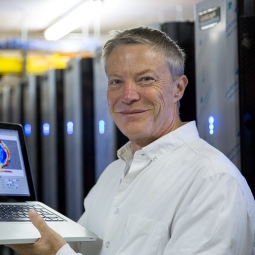Ocean robots and global climate modelling in SOCCO’s future
CSIR researchers at the Southern Ocean Carbon & Climate Observatory (SOCCO) will put five years of climate and ocean study to the test as part of the international Good Hope-SOSCEx 2019 Experiment. Dr Pedro Monteiro hopes that the outcome of this coordinated South African polar community experiment will improve climate projections for the rest of the century, an important step for local and global climate mitigation and adaptation.
CSIR researchers at the Southern Ocean Carbon & Climate Observatory (SOCCO) will put five years of climate and ocean study to the test as part of the international Good Hope-SOSCEx 2019 Experiment. Dr Pedro Monteiro hopes that the outcome of this coordinated South African polar community experiment will improve climate projections for the rest of the century, an important step for local and global climate mitigation and adaptation.
The study will put SOCCO’s pioneering work with ocean robots in the Southern Ocean to use in understanding the effect of fine-scale ocean dynamics on climate.
Monteiro is chief oceanographer at the CSIR, with a special interest in understanding how and why oxygen and carbon levels in the ocean adjust to climate variability and change. He initiated the SOCCO programme in 2012 to study the link between the Southern Ocean and climate in two main ways.
“First, we want to understand how ocean physics affects carbon dioxide (CO2) exchange between the ocean and atmosphere,” he says. “Second, we want to understand the effect of biological activity on carbon – how primary production plays a role in carbon uptake, and how that influences the carbon cycle.”
He describes these broad lenses of the programme as ‘physics and carbon’, and ‘biology and carbon’, which neatly sum up SOCCO’s science strategy for the past five years and the foreseeable future.
According to Monteiro, the success of SOCCO lies in the strong interdisciplinary group made up of CSIR researchers and postgraduate students from many universities, which has been built up over five years.
In trying to understand the role of the Southern Ocean carbon cycle in the global climate system, SOCCO has been the perfect platform to provide young South Africans with advanced training in science and engineering as well as strengthen international visibility of South Africa’s science. In so doing, SOCCO has helped develop human capital – a core goal of the programme.
Monteiro has led the SOCCO programme for the past five years, contributing to global and regional scientific challenges in three main areas. The first of these is measuring the effects of fine-scale ocean dynamics on the interplay between Southern Ocean carbon and global climate.
Many medium-to-coarse global models simulate the global climate system at a resolution that mostly disregards the effects of fine-scale dynamics, in order to make long-term projections (more than a century).
“The problem is that many physical and biogeochemical processes happen on a scale that is not visible as computed by the model,” says Monteiro. “We had to work out whether it matters that climate and earth systems models do not simulate those fine-scale processes.”
The second challenge was to establish a long-term carbon observation programme. SOCCO has now used the programme to estimate average CO2 exchange between the Southern Ocean and the atmosphere with enough precision to measure year-to-year changes related to climate. With this, the SOCCO team will better understand the changing carbon cycle in the Southern Ocean as well as test model results and how this will affect long-term carbon mitigation strategies around the world.
Thirdly, SOCCO worked with colleagues at the CSIR in Pretoria to develop Africa’s first earth systems model. Led by Professor Francois Engelbrecht of the climate studies, modelling and environmental health research group at the CSIR, the SOCCO team addressed the problems that earth systems models have with the carbon cycle of the Southern Ocean.
“Our earth systems model is going to be South Africa’s contribution to the Intergovernmental Panel on Climate Change (IPCC) 6th Assessment Report in 2021,” Monteiro says. “One of the unique and interesting aspects of our contribution will be addressing some of the biases that exist in earth systems globally in the Southern Ocean.”
The CSIR has signed a contract with the Department of Science and Technology which sets the science strategy of the SOCCO programme up to the year 2020. Monteiro says they are aiming to better understand and project the feedback between carbon and climate in the Southern Ocean in the second half of the the 21st century.
“One of the highlights, we expect, will be an experiment starting in the winter of 2018 and ending in the late summer of 2019,” he says. “The international experiment will combine robotics and ship-based observations to test some hypotheses from earlier SOCCO research.”
Of all the plans SOCCO will be embarking on, Monteiro sees the use of ocean robotics as the most exciting prospect. The drones used for SOCCO ocean research have already seen several spinoffs beyond research.
SOCCO can use their ocean-going robots to conduct low-cost surveys of fish stocks off the west coast of South Africa. Engineers are also innovating in sensor development, and they will start making SOCCO’s first CO2 sensor available internationally in the second half of 2018.
“Funding basic research can lead to technological innovation which would not otherwise happen,” says Monteiro. “We hope that our technological innovation will create small and medium enterprises that will take this tech into the ocean services and climate services industry.”
“We are trying to make the link between basic science and economic development.”



